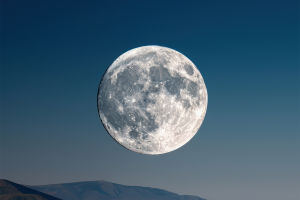The Full Moon occurs when Earth aligns perfectly between the Sun and the Moon. This celestial alignment allows the sunlight to illuminate the entire visible side of the Moon.
As the Moon orbits Earth, the angle of sunlight changes, giving rise to different lunar phases.
When is the Next Full Moon?
The next Full Moon is the first Full Moon of 2025, known as the Wolf Moon. It is set to occur at 5:27 p.m. on Monday, January 13, 2025.
2025 Full Moon Calendar and Their Traditional Names
Below is the complete schedule of 2025’s Full Moons along with their traditional names. All times are in Eastern Time (denotes a Super Moon):
Monday, Jan. 13 — 5:27 p.m. — Wolf Moon
Wednesday, Feb. 12 — 8:53 a.m. — Snow Moon
Friday, March 14 — 2:55 a.m. — Worm Moon
Saturday, April 12 — 8:22 p.m. — Pink Moon
Monday, May 12 — 12:56 p.m. — Flower Moon
Wednesday, June 11 — 3:44 a.m. — Strawberry Moon
Thursday, July 10 — 4:37 p.m. — Buck Moon
Saturday, Aug. 9 — 3:55 a.m. — Sturgeon Moon
Sunday, Sept. 7 — 2:09 p.m. — Corn Moon
Monday, Oct. 6 — 11:48 p.m. — Hunter’s Moon
Wednesday, Nov. 5 — 8:19 a.m. — Beaver-Moon
Thursday, Dec. 4 — 6:14 p.m. — Cold Moon
The Phases of the Moon in January 2025
The phases of the Moon in January 2025 are as follows:
Monday, January 6
First Quarter Moon: 6:56 p.m. EST
Moon Phase: Waxing crescent (47%)
Tuesday, January 7
Moon reaches perigee (closest to Earth): 7:01 p.m. EST
Moon Phase: Waxing gibbous (59%)
Wednesday, January 8
Moon Phase: Waxing gibbous (70%)
Thursday, January 9
Moon occults several stars in the Pleiades star cluster.
Moon Phase: Waxing gibbous (79%)
Friday, January 10
Moon passes near Jupiter.
Moon Phase: Waxing gibbous (88%)
Saturday, January 11
Moon Phase: Waxing gibbous (94%)
2025 Full Moon Calendar: Supermoons, Blood Moons, and Must-See Lunar Events
Video by WISDOM SMKA
Moon Phases and Their Cycle
The lunar cycle comprises several phases: New Moon, waxing crescent, First Quarter, waxing gibbous, Full Moon, waning gibbous, Last Quarter, and waning crescent. A complete lunar cycle lasts approximately 29.5 days, termed a synodic month.
Special Names for Full Moons
Dear Lykkers, full Moons carry unique names rooted in cultural, agricultural, and natural observations:
Wolf Moon (January): Reflecting the cries of hungry wolves.
Snow Moon (February): Linked to heavy snowfall.
Worm Moon (March): Celebrating the thawing grounds and earthworms.
Pink Moon (April): Inspired by blooming wildflowers.
Flower Moon (May): Honoring the blossoming flowers.
Strawberry Moon (June): Signifying the strawberry harvest.
Buck Moon (July): Noting the growth of antlers on bucks.
Sturgeon Moon (August): Highlighting the abundance of sturgeon fish.
Corn Moon (September): Celebrating the corn harvest.
Hunter’s Moon (October): Symbolizing the hunting season.
Beaver-Moon (November): Reflecting the-beaver’s dam-building activities.
Cold Moon (December): Evoking the chill of winter.
Additional terms include:
Super Moon: A Full Moon occurring near its closest approach to Earth, appearing brighter and larger.
Blue Moon: The second Full Moon in a month with two Full Moons.
Harvest Moon: The Full Moon nearest the autumnal equinox, often displaying an orange hue.
Each Full Moon has a story, enriching the celestial journey through time and culture.


